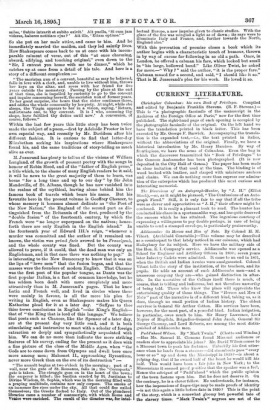Addiscombe: its Heroes and Men of Note. By Colonel H.
M. Vibart. (Archibald Constable.)—This volume may be described as a counterpart to that lately noticed in our columns, which had Haileybury for its subject. Here we have the military side of the Hon. E. I. Company's service. Addiscombe was opened as a School for Engineer and Artillery Officers in 1809; seven years later Infantry Cadets were admitted. It came to an end in 1861, when the British and Indian Armies were amalgamated. Colonel Vibart tells the story of the institution, of its teachers, and its pupils. He adds an account of such Addiscombe men—and a numerous company they are—who gained distinction in after- life. In the narrative of the College itself there is much, of course, that is trifling and ludicrous, but not therefore unworthy of being told. Those who knew the place will appreciate the entertaining quality of these things. The "Heroes and Men of Note" part of the narrative is of a different kind, taking us, as it does, through no small portion of Indian history. The oldest survivor is General Sir Arthur Cotton. His services have been, however, for the most part, of a peaceful kind. Indian irrigation, in particular, owes much to him. Sir Henry Lawrence, Lord Napier of Magdala, Brigadier-General John Jacob, General Sir George Chesney, and Lord Roberts, are among the most distin- guished of Addiscombe men.


































 Previous page
Previous page